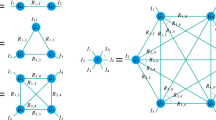Abstract
Tensor completion aims at recovering missing data, and it is one of the popular concerns in deep learning and signal processing. Among the higher-order tensor decomposition algorithms, the recently proposed fully-connected tensor network decomposition (FCTN) algorithm is the most advanced. In this paper, by leveraging the superior expression of the fully-connected tensor network (FCTN) decomposition, we propose a new tensor completion method named the fully connected tensor network weighted optimization (FCTN-WOPT). The algorithm performs a composition of the completed tensor by initializing the factors from the FCTN decomposition. We build a loss function with the weight tensor, the completed tensor and the incomplete tensor together, and then update the completed tensor using the lbfgs gradient descent algorithm to reduce the spatial memory occupation and speed up iterations. Finally we test the completion with synthetic data and real data (both image data and video data) and the results show the advanced performance of our FCTN-WOPT when it is applied to higher-order tensor completion.
Access this chapter
Tax calculation will be finalised at checkout
Purchases are for personal use only
Similar content being viewed by others
Notes
- 1.
The data is available at http://openremotesensing.net/kb/data/.
- 2.
The data is available at http://trace.eas.asu.edu/yuv/.
- 3.
Homepage: http://gtl.inrialpes.fr/.
References
Kolda, T.G., Bader, B.W.: Tensor decompositions and applications. SIAM Rev. 51(3), 455–500 (2009)
Oseledets, I.V.: Tensor-train decomposition. SIAM J. Sci. Comput. 33(5), 2295–2317 (2011)
Zhao, Q., Zhou, G., Xie, S., et al.: Tensor ring decomposition. arXiv preprint arXiv:1606.05535 (2016)
Song, Q., Ge, H., Caverlee, J., Hu, X.: Tensor completion algorithms in big data analytics. ACM Trans. Knowl. Discovery Data 13, 1–48 (2019)
Bazerque, J.A., Mateos, G., Giannakis, G.B.: Rank regularization and Bayesian inference for tensor completion and extrapolation. IEEE Trans. Signal Process. 61(22), 5689–5703 (2013)
Ding, M., Huang, T.-Z., Ji, T.-Y., Zhao, X.-L., Yang, J.-H.: Low-rank tensor completion using matrix factorization based on tensor train rank and total variation. J. Sci. Comput. 81(2), 941–964 (2019). https://doi.org/10.1007/s10915-019-01044-8
Gandy, S., Recht, B., Yamada, I.: Tensor completion and low-n-rank tensor recovery via convex optimization. Inverse Prob. 27(2), 025010 (2011)
Yu, D., Deng, L., Seide, F.: The deep tensor neural network with applications to large vocabulary speech recognition. IEEE Trans. Audio Speech Lang. Process. 21(2), 388–396 (2012)
Mahyari, A.G., Zoltowski, D.M., Bernat, E.M., et al.: A tensor decomposition-based approach for detecting dynamic network states from EEG. IEEE Trans. Biomed. Eng. 64(1), 225–237 (2016)
Guo, X., Huang, X., Zhang, L., et al.: Support tensor machines for classification of hyperspectral remote sensing imagery. IEEE Trans. Geosci. Remote Sens. 54(6), 3248–3264 (2016)
Zheng, Y.B., Huang, T.Z., Zhao, X.L., et al.: Fully-connected tensor network decomposition and its application to higher-order tensor completion. In: Proceedings of the AAAI Conference on Artificial Intelligence, vol. 35(12), pp. 11071–11078 (2021)
Hu, W., Tao, D., Zhang, W., et al.: The twist tensor nuclear norm for video completion. IEEE Trans. Neural Networks Learn. Syst. 28(12), 2961–2973 (2016)
Yuan, M., Zhang, C.H.: On tensor completion via nuclear norm minimization. Found. Comput. Math. 16(4), 1031–1068 (2016)
Yu, J., Li, C., Zhao, Q., et al.: Tensor-ring nuclear norm minimization and application for visual: data completion. In: ICASSP 2019–2019 IEEE International Conference on Acoustics, Speech and Signal Processing (ICASSP), pp. 3142–3146. IEEE (2019)
Yuan, L., Cao, J., Zhao, X., et al.: Higher-dimension tensor completion via low-rank tensor ring decomposition. In: 2018 Asia-Pacific Signal and Information Processing Association Annual Summit and Conference (APSIPA ASC), pp. 1071–1076. IEEE (2018)
Liu, Y.Y., Zhao, X.L., Song, G.J., et al.: Fully-connected tensor network decomposition for robust tensor completion problem. arXiv preprint arXiv:2110.08754 (2021)
Ahad, A., Long, Z., Zhu, C., et al.: Hierarchical tensor ring completion. arXiv preprint arXiv:2004.11720 (2020)
Acar, E., Dunlavy, D.M., Kolda, T.G., Mørup, M.: Scalable tensor factorizations for incomplete data. Chemom. Intell. Lab. Syst. 106(1), 41–56 (2011)
Yuan, L., Li, C., Mandic, D., et al.: Tensor ring decomposition with rank minimization on latent space: an efficient approach for tensor completion. In: Proceedings of the AAAI Conference on Artificial Intelligence, vol. 33, no. 01, pp. 9151–9158 (2019)
Wang, W., Aggarwal, V., Aeron, S.: Efficient low rank tensor ring completion. In: Proceedings of the IEEE International Conference on Computer Vision, pp. 5697–5705 (2017)
Chen, Y., He, W., Yokoya, N., et al.: Nonlocal tensor-ring decomposition for hyperspectral image denoising. IEEE Trans. Geosci. Remote Sens. 58(2), 1348–1362 (2019)
He, W., Chen, Y., Yokoya, N., et al.: Hyperspectral super-resolution via coupled tensor ring factorization. Pattern Recogn. 122, 108280 (2022)
Author information
Authors and Affiliations
Corresponding author
Editor information
Editors and Affiliations
Rights and permissions
Copyright information
© 2022 The Author(s), under exclusive license to Springer Nature Switzerland AG
About this paper
Cite this paper
Yang, P., Huang, Y., Qiu, Y., Sun, W., Zhou, G. (2022). A High-Order Tensor Completion Algorithm Based on Fully-Connected Tensor Network Weighted Optimization. In: Yu, S., et al. Pattern Recognition and Computer Vision. PRCV 2022. Lecture Notes in Computer Science, vol 13534. Springer, Cham. https://doi.org/10.1007/978-3-031-18907-4_32
Download citation
DOI: https://doi.org/10.1007/978-3-031-18907-4_32
Published:
Publisher Name: Springer, Cham
Print ISBN: 978-3-031-18906-7
Online ISBN: 978-3-031-18907-4
eBook Packages: Computer ScienceComputer Science (R0)




